It’s a puzzle, for sure, from start to finish. But the good news is that as we get closer to the finish we begin to see a pattern, a design; it starts to come together as something, well, beautiful. The borders are there already, and the interior pieces are mostly in place. Yes, there are gaps, blank spaces, question marks. But overall, it’s been worthwhile, this life as a jigsaw puzzle.
As longtime readers of my blogposts know, I tend to look for metaphors everywhere for everything. Why not life as a jigsaw puzzle now?
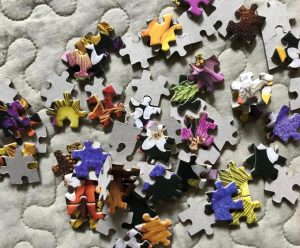
During the COVID lockdown, for the first time in my life, I did a whole jigsaw puzzle by myself, and I began, piece by piece, to understand the attraction. It takes patience, focus, and tenacity – like any worthy life endeavor – but when it’s done, there’s cause for rejoicing.
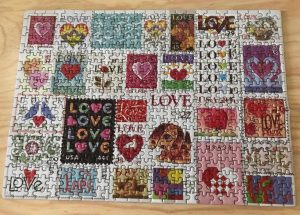
Then this past week, after coming to live temporarily with my friend Nancy at her condo in San Miguel de Allende, Mexico, while I decide what move to make next on my life’s big puzzle board, I was reminded of jigsaw puzzles’ appeal.
One of Nancy’s many interests is doing jigsaw puzzles. For her, puzzling is a mental challenge, a pleasant pastime, and pure joy. She sometimes receives puzzles as gifts from friends, and then, once completed, she passes them on to others. “It’s a sharing thing,” she says.
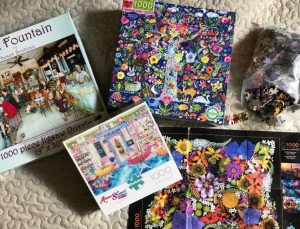
My dearest, oldest friend Kathy, who was my roommate when we were students at the Katherine Gibbs School in Montclair, New Jersey, almost sixty years ago, is especially hooked on puzzling now. As she told me in a recent e-mail:
“Surprisingly, jigsaw puzzles are not frustrating for me! Once all the edges have been placed and all the pieces are face-up, I decide where to begin. I love the organizational skills one must use in order to complete a puzzle, and I also love the fact that when I’m puzzling, my total focus is on that puzzle. Worries and stress don’t exist. Puzzles take me somewhere else, they give me focus, they bring me a sense of accomplishment. And they’re fun!”
The first jigsaw puzzle she bought, she told me, was in the summer of 2018 when her son and his family were visiting on their vacation. “I thought it would be a fun family activity, appealing to all of us,” Kathy said, “but the grandkids really weren’t too interested at that time.”
“Getting away from the mindlessness of TV and technology and enjoying an activity together was my reason for that first purchase,” she said. “Carl [Kathy’s son] wasn’t interested at first, but he quickly joined [his wife] Colby and me in the race to finish the 1,000-piece puzzle before they left for home.
“And finish it we did! I can recall like it was yesterday the great laughs and good talks we had doing that first puzzle together. That sense of happiness — and the cheering we did — when that final puzzle piece was put in place did my heart good.”
For Kathy, too, COVID was a turning point. When COVID came along, she said, she really became a puzzle lover:
“It helped pass the time and helped me to think about something other than the pandemic,” she said. “And, especially at this age, I find it important to know that I can actually focus on something for a long period of time and I can complete something so complex.”
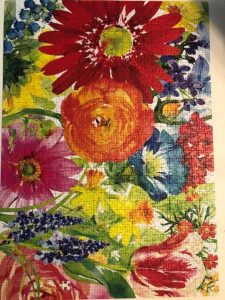
Like Nancy, Kathy derives extra joy in passing her completed puzzles along to her puzzle-loving friends, knowing that they too will have many hours of pleasure putting them together.
Originally, jigsaw puzzles were created as teaching tools for children, I learned. The first jigsaw puzzle was invented by an English map engraver named John Spilsbury in 1762. He mounted one of his master maps onto wood and then cut around the countries. He then gave these puzzles to children in the local school to help the children with their geography education. Spilsbury’s invention was an instant hit, and the concept was soon copied by others and expanded into other educational images. (For the full history, go to:
https://www.wentworthpuzzles.com/us/2019/05/07/history-of-jigsaw-puzzles )
We’ve come a long way since then, of course. And for me, the strangely shaped yet interlocking pieces of jigsaw puzzles – and the effort that it takes to connect them and make of them things of beauty — offer us grownups lessons worth pursuing.

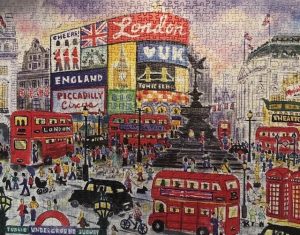
I love jigsaw puzzles and the bit of history you shared! Thanks for the reminder Bonnie, and I’m glad to hear you are already having fun in your new “situation.” xoxoxo
Thanks, dear Kim! Yes, I’m thankful to be here. 🙂 I hope you, too, are doing well. — xx
I will have to try a puzzle sometime. In Spanish, they are called “rompecabezas” (At least in Cuban Spanish). Literally “break your head”!
Yes, do try, Te. I know you’ll enjoy it. Maybe Gary will too. And, yes, I’ve heard them called the same here in MX. — Abrazos, BB xx
I love your metaphors!
Thanks, Te! — xx
Bonnie, if you haven’t seen it, you and Nancy would love PUZZLE. It’s a wonderful movie about the passion of puzzling. xoxo~Be
Ah! No, I haven’t seen it, Be! I’ll ask Nancy if she has and whether we can catch it on her TV/movie subscriptions. Thanks! — xx
Dear Bon,
My dad loved to do jigsaw puzzles, and he did them for all the years he was retired. In our school library, our wonderful librarian (and really, is there any other kind?) always has a table with a jigsaw puzzle in progress. At first, I was a bit mystified why a high school library would have a puzzle table. Then, as I observed, students would pass by and work on it for varying lengths of time, and then they move on. It’s a brain-cleansing exercise, and they always walked away happy. No one could deny the benefit of a happy student.
Love,
Paul
What a lovely true story, dear Paul! I can just see your students there, placing puzzle pieces in their correct spots before running off to class. Thanks for sharing. — LU2, BB xx
Loved this “piece” Bonnie (piece ha ha ha). Our mother would often have a puzzle out when we were older kids. She’d work on other awhile and leave it out for any of the rest of us who would sit down for a bit, too. Sometimes many of us would work on it at the same time. Great pass time. The hardest one was called “Little Red Riding Hood’s Hood”, an all red round puzzle with NO detail. Just one shade of red. It was too hard and I think it was a long time after that before another puzzle came out. My sister Lee here does puzzles also and has done a few puzzle exchanges with friends. I sometimes late at night add a few pieces and she wakes up to find a puzzle just a little further along.
I’m loving these puzzle stories, dear Lyn! Thank you for sharing yours. — BB
As an adult I bought a child’s puzzle of the United States. Each state was one piece. As a kid we moved around alot and my education was kind of spotty on certain things. For example, I learned about the reproduction of animals three different times in three different science classes at three different junior high schools. History of the United States and the U.S. map I missed alot, and that Texas prioritizes Texas history over every other history, same with Oklahoma, didn’t help. In high school in Kansas a history teacher early in the year gave us a U.S. map with state borders only and a number in each state. Then a sheet of paper numbered one to fifty. We were to fill in each state from memory based on its shape and location. For those of us who missed alot he gave the quiz again periodically throughout the year. Eventually he gave up on me, probably once he realized a bunch of other basic U.S. history I didn’t know. Anyway, years and years later as an adult I bought a U.S. map puzzle to try again. At least now I could tell you what region of the country a state is in. Texas and Oklahoma of course I always got right.
Thanks for another fun puzzle story, Lyn! 🙂
Thank you for these thoughts. I have loved jigsaw puzzles for years, and I began working many more during the pandemic and trading puzzles with my friend of 50 plus years. I have also donated puzzles to our local Friends of the Library resale store, then I pick out other puzzles to work for $2. Such a good cause in RIo Rancho, NM!
Thank YOU, Susan! Great to hear from you and learn your puzzle story!